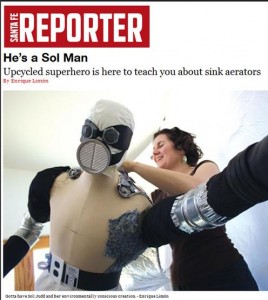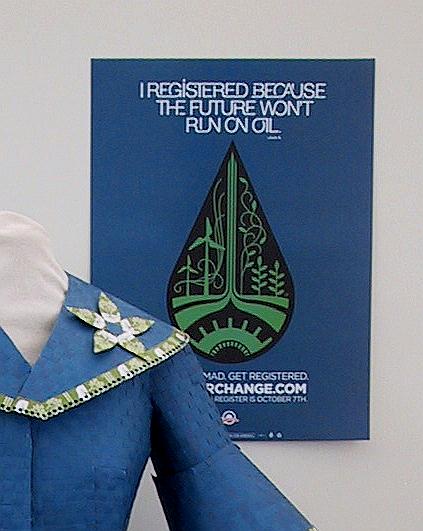Upcycled superhero is here to teach you about sink aerators
 June, 4, 2013
June, 4, 2013
By Enrique Limón
Read the article and see photos on line.
It’s a bird…it’s a LEED-certified plane…it’s Sol Man, Santa Fe’s own conservationist superhero!
“This is the Man in progress,” artist and environmental educator Nancy Judd says, leading the way to her studio where the work-in-progress lies, striking a classic flying-through-midair pose.
“This is the first time I’ve done anything specifically in energy conservation,” Judd, the head of Recycle Runway and co-founder of Recycle Santa Fe Art Market, says. “I make couture fashion sculptures from trash, and I use them to raise awareness about environmental issues.”
The city’s former recycling coordinator achieves this by setting up installations in high foot-traffic locations like shopping malls, airports and museums.
Sol Man is no exception, being that he’ll be unveiled this Wednesday at 4 pm at the Santa Fe Place Mall.
Utensils galore line Judd’s worktable, including pliers, heavy-duty gloves (“his cape still has sharp edges,” she warns), and a chart of the “ideal-proportion male.”
“For me, as an artist, this has been a really challenging process,” Judd says, working on Sol’s head. His torso is a discarded dress form rescued from a dumpster; his legs and arms were once conduit, covered with pipe insulation; and his bulging “muscles” are made from downcycled home insulation.
Other elements in the figure include rubber gasket scraps, yard signs from past political campaigns and ventilation ducts.
“My stuff is usually very feminine,” Judd confesses, “so making this guy—who is everything but—has been a challenge.”
Like every fabled crusader before him, Sol Man has a chimerical backstory.
It starts in an Ortiz Middle School science classroom. “The kids learned about where energy comes from, different energy sources, problems with different energy sources and about energy conservation,” the artist says.
During the students’ three-week immersion, Judd says they were assigned energy-conservation projects at home.
“PNM, our local electric company, provided them one of these energy-efficiency kits,” she says, opening up a small box containing compact fluorescent light bulbs, a low-flow shower head, a fridge thermometer and other green household implements—several of which now rest on the Man’s belt.
During that time, Judd also went into the sixth-graders’ art class—where, collectively, Sol Man’s look was born.
“I worked with them and said, ‘We’re gonna create an energy-efficient superhero. What would he look like?’”
The result was a slew of drawn submissions, with names like “Shiny Woman,” “Super Energy Conserver” and “Corserva-Woman”—who boasts a “built-in nightlight.”
“I took some of their ideas and created this guy,” Judd says.
Approaching the same students, this time at their Consumer Science class, Sol Man’s different elements—like the 300 mini faux solar panels that adorn his cape—came to be.
After his stint at the mall, Sol Man will tour statewide to continue his mission of raising energy awareness.
“In the long run, I want people to conserve energy,” Judd says of her efforts, realized in part through a fellowship awarded by Toyota and the National Audubon Society. “I want to raise awareness about our environmental impact as individuals—and energy is one of those places where we have a huge impact.”
She’s aware the message is trite, but insists, “energy is a huge, huge problem because it’s one of our main sources of CO2, which is one of the leading causes of climate change.”
Judd hopes her initiative sets a [low-emission] spark across the local art community and motivates others in her position to marry their creativity with bigger causes.
“One of the connections that I make about the work that I do is that, in the coming years, as we face climate change, we’re gonna have to use incredible creativity,” she says.
“Whether that’s the creativity of an artist to educate, or the creativity of an engineer to help solve problems, an inventor or even a politician on how to get laws passed—all of that is really about creative problem solving,” Judd continues. “And the bigger the problem, the more creativity we’re gonna need.”








































